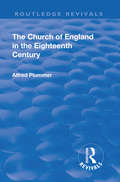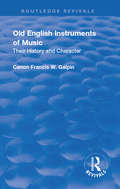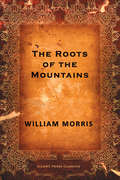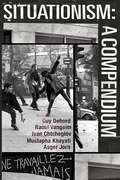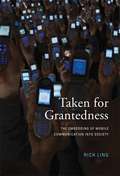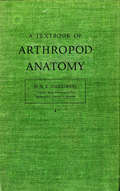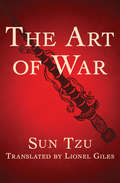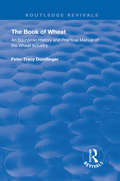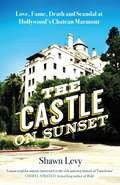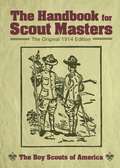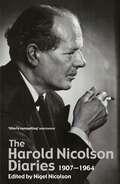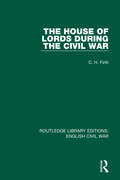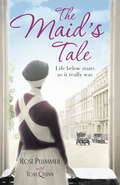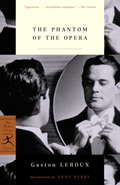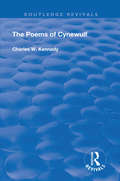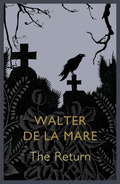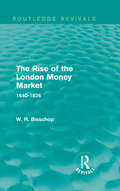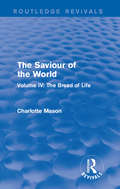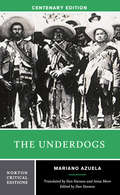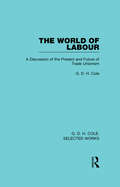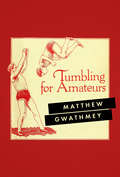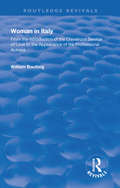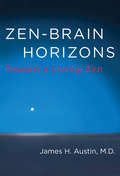- Table View
- List View
Revival: The Church of England in the Eighteenth Century (Routledge Revivals)
by Plummer AlfredIn a period of which so much is known, and of which the materials for additional knowledge are so abundant, as is the case with the eighteenth century, the writer of a handbook sees from the first that a very great deal, of even important matters, will have to be omitted: and one of his chief difficulties will be to decide which topics must be selected in order to give the reader an intelligible and coherent picture – faithful, as far as it goes – of the period as a whole.
Revival: Their History and Character (Routledge Revivals)
by Francis W. GalphinThe study of musical instruments now no longer with us is necessary, not only for the musician and composer, but for the man of letters, the artist, and the chronicler of our national life; for many allusions to customs of bygone times cannot otherwise be understood, and we should be spared such a trying ordeal as we were recently subjected to by one of our leading illustrated papers, which introduced into a thirteenth century scene a twentieth century mandoline with an up to date mechanism.
Roots of the Mountains
by William MorrisThe lives of the peaceful, artistic Dalemen are disrupted when the Wolfings and an army of Huns invade the Burgdales.
Situationism: A Compendium
by Guy Debord Ivan Chtcheglov Mustapha Khayati Raoul Vaneigem Asger JornAfter Guy Debord's seminal Society of the Spectacle, this new compendium brings together eight other important situationist works. Ivan Chtcheglov opens proceedings via his Formulary for a New Urbanism (1953), with it's quasi-mythical demand that resonated down through generations: "The hacienda must be built", followed by two brief but illuminating pieces from Asger Jorn, who's sandpaper book cover later turned up under the same Factory Records roof as Manchesters' own Hacienda, on the Durrtti Column's "Return of the Durrutti Column" ( the title itself lifted from Andre Bertrand's détourned pro-situ comic strip). Debord's The Decline and Fall of the Spectacle-Commodity Economy-was an immediate, razor sharp response to the LA/Watts Riots of 1965, it's analysis of the relationship between the rioter and the meaningless, unaffordable commodities they loot or destroy resonating heavily today. Tunisian situationist Mustapha Khayati contributes Address to Revolutionaries of Algeria and of All Countries and the game changing "On the Poverty of Student Life", the match that arguably lit the fires of May 68'. Raoul Vaneigem's The Revolution of Everyday Life finishes things off in defiant fashion : ". You're f*%@g Around With Us? -- Not For Long!"
Taken for Grantedness
by Rich LingWhy do we feel insulted or exasperated when our friends and family don't answer their mobile phones? If the Internet has allowed us to broaden our social world into a virtual friend-net, the mobile phone is an instrument of a more intimate social sphere. The mobile phone provides a taken-for-granted link to the people to whom we are closest; when we are without it, social and domestic disarray may result. In just a few years, the mobile phone has become central to the functioning of society. In this book, Rich Ling explores the process by which the mobile phone has become embedded in society, comparing it to earlier technologies that changed the character of our social interaction and, along the way, became taken for granted. Ling, drawing on research, interviews, and quantitative material, shows how the mobile phone (and the clock and the automobile before it) can be regarded as a social mediation technology, with a critical mass of users, a supporting ideology, changes in the social ecology, and a web of mutual expectations regarding use. By examining the similarities and synergies among these three technologies, Ling sheds a more general light on how technical systems become embedded in society and how they support social interaction within the closest sphere of friends and family
Textbook of Arthropod Anatomy
by R. E. SnodgrassThe facts of arthropod structure are presented in clear, easy-to-use fashion in this text by R. E. Snodgrass. Examples of each of the classes from trilobites to insects are given. Musculature and mechanism of legs, eyes, feeding apparatus, body, head, and organs of digestion, excretion, and reproduction are described and illustrated.Over 640 drawings, most of them by the author, are arranged in 88 figures.
The Art of War: The Essential Translation Of The Classic Book Of Life (Penguin Modern Classics Series #909)
by Sun TzuThe world&’s most influential treatise on strategy Mao Zedong used it to defeat Chiang Kai-shek. Colin Powell thinks every US soldier should be familiar with its principles. New England Patriots coach Bill Belichick built a football dynasty out of lessons learned within its pages. Even Gordon Gekko and Tony Soprano are fans. In the twenty-five hundred years since it was composed, The Art of War has been applied to just about every field of human endeavor. Sun Tzu&’s shrewd advice is indispensible to anyone seeking to gain an advantage over an opponent.
The Book of Wheat: An Economic History and Practical Manual of the Wheat Industry (Routledge Revivals)
by Peter Tracy DondlingerFirst published in 1910, this volume was the result of fifteen years of study in the American Northwest. The author contributed to the burgeoning field of industrial and economic history, providing a practical manual for the entirety of the wheat industry at the time. Whilst smaller studies had been published before, this was the first general work on the subject, covering topics including the wheat plant, cultivation, diseases, marketing and production. It was of particular interest to growers, dealers and millers and was accessible to popular readers, students, instructors and experimenters.
The Castle on Sunset: Love, Fame, Death and Scandal at Hollywood's Chateau Marmont
by Shawn LevyFor nearly ninety years, Hollywood's brightest stars have favoured the Chateau Marmont as a home away from home. Filled with deep secrets but hidden in plain sight, its evolution parallels the growth of Hollywood itself. Perched above the Sunset Strip like a fairy-tale castle, the Chateau seems to come from another world entirely. An apartment-house-turned-hotel, it has been the backdrop for generations of gossip and folklore: 1930s bombshell Jean Harlow took lovers during her third honeymoon there; director Nicholas Ray slept with his sixteen-year-old Rebel Without a Cause star Natalie Wood; Anthony Perkins and Tab Hunter met poolside and began a secret affair; Jim Morrison swung from the balconies, once nearly falling to his death; John Belushi suffered a fatal overdose in a private bungalow; Lindsay Lohan got the boot after racking up nearly $50,000 in charges in less than two months. Much of what's happened inside the Chateau's walls has eluded the public eye - until now. With wit and prowess, Shawn Levy recounts the wild parties and scandalous liaisons, creative breakthroughs and marital breakdowns, births and untimely deaths that the Chateau Marmont has given rise to. Vivid, salacious and richly informed, the book is a glittering tribute to Hollywood as seen from the suites and bungalows of its most hallowed hotel.
The Handbook for Scout Masters: The Original 1914 Edition
by The Boy Scouts of AmericaNow Available Again, the Original 1914 Rules, Regulations, and Lessons Necessary for Boy Scout Leaders First published in 1914, the Handbook for Scout Masters was the foremost compendium on leading and guiding a Boy Scout troop. Here, word for word, you can read all about just what it took to be a Scout Master, with a focus on the boys themselves. After all, the Boy Scouts&’ main purpose was &“not to exploit methods, not glorify movements . . . but to lead boys into useful lives&” (from the Introduction). Chapters from this classic, standard handbook include: Scout RequirementsPrinciples and MethodsTroop and Patrol ManagementDrills and DemonstrationsChivalry and MoralityAnd more! From age limits, hierarchies, and oaths to lessons on cooking, first aid, and nature, The Handbook for Scout Masters covers all the basics of what it took to lead a Boy Scout troop. Scouts and scout masters alike will love reading about the original guidelines to one of America&’s most well-known youth organizations.
The Harold Nicolson Diaries: 1907-1964
by Harold NicolsonOne of the great 20th century political diaries'Brilliant, riveting stuff' TRIBUNE'One stops to marvel at the achievement. Honesty, decency, modesty, magnanimity, are stamped on every page, as evident as the wit' EVENING STANDARD'A tremendous read' SPECTATORHarold Nicolson was one of the three great political diarists of the 20th century (along with Chips Channon and Alan Clark). Nicolson was an MP (Conservative, 1935-45, who also flirted with Labour after WWII). He had previously been in the Foreign Office and attended the Paris Peace Conference in 1919, and material from this period is included in this new edition for the first time. Nicolson never achieved high office, but rarely a day went by when he didn't record what was going on at Westminster. He socialised widely, was married to the poet and author Vita Sackville-West, and together they created the famous garden at Sissinghurst. Both were bi-sexuals and had affairs outside their marriage. This new edition also draws on diary entries and letters previously considered too sensitive for inclusion. The diversity of Harold Nicolson's interests and the irony in his writing make his diary a highly entertaining record of his life and times, as well as a document of great historical value.
The Harold Nicolson Diaries: 1907-1964
by Harold NicolsonOne of the great 20th century political diaries'Brilliant, riveting stuff' TRIBUNE'One stops to marvel at the achievement. Honesty, decency, modesty, magnanimity, are stamped on every page, as evident as the wit' EVENING STANDARD'A tremendous read' SPECTATORHarold Nicolson was one of the three great political diarists of the 20th century (along with Chips Channon and Alan Clark). Nicolson was an MP (Conservative, 1935-45, who also flirted with Labour after WWII). He had previously been in the Foreign Office and attended the Paris Peace Conference in 1919, and material from this period is included in this new edition for the first time. Nicolson never achieved high office, but rarely a day went by when he didn't record what was going on at Westminster. He socialised widely, was married to the poet and author Vita Sackville-West, and together they created the famous garden at Sissinghurst. Both were bi-sexuals and had affairs outside their marriage. This new edition also draws on diary entries and letters previously considered too sensitive for inclusion. The diversity of Harold Nicolson's interests and the irony in his writing make his diary a highly entertaining record of his life and times, as well as a document of great historical value.
The House of Lords During the Civil War
by C. H. FirthOriginally published in 1910, this book traces the political role of the House of Lords during the first half of the seventeenth century, from its early years of defending the constitution against the crown, and the subsequent conflict with the Lower House during the Civil War, to its abolition in 1649 and restoration eleven years later.
The Maid's Tale: A revealing memoir of life below stairs
by Tom Quinn Rose PlummerPraise for Lives of the Servants: `Reading this fascinating book is likely to unleash almost anyone?s Inner Bolshevik?!' Daily Mail `...a fascinating portrait of the drudgery and servility of a domestic's life.' The Age `...captures the subtleties of the English class system to an extraordinary degree.' Midstate Observer 'If the Brothers Grimm had ended Cinderella where she was being forced to clean the house by her stepsisters, they might have accidentally been writing Rose Plummer's biography. The maid's story makes for harsh, heartbreaking, fascinating reading.? The Daily Telegraph, NZ Born in 1910, Rose Plummer grew up in an East End slum, where she and fought an unending battle with hunger and squalor. At the age of fifteen, Rose started work as a live-in maid, and despite the poverty of her childhood, nothing could have prepared her for the long hours, the backbreaking work and the harshness of a world in which servants were treated as if they were less than human. But however difficult life became, Rose found something to laugh about, and her remarkable spirit and gift for friendship shines through in her memories of a now-vanished world.
The Phantom of the Opera
by Gaston LerouxThe Phantom of the Opera (in French, Le Fantome de l'Opera) is a French novel by Gaston Leroux. It was first published as a serialization in Le Gaulois from September 23, 1909 to January 8, 1910. Some believe it to have been inspired by George du Maurier's Trilby. Trilby is based on real events related to the Paris Opera House which Leroux investigated, initiated by stories of an opera house ghost. Initially, the novel sold very poorly and was even out of print several times during the twentieth century. Today, it is considered to be a classic of French literature, though it is overshadowed by its many subsequent adaptations. The novel was translated into English in 1911. It has since been adapted many times into film and stage productions, the most notable of which were the 1925 film depiction and Andrew Lloyd Webber's 1986 musical, starring Michael Crawford as the Phantom, Steve Barton as Raoul, and Sarah Brightman as Christine, which is now the longest running Broadway show in history and the most lucrative entertainment enterprise of all time, its worldwide box office over the past 20 years out-grossing even the highest grossing film in history, Titanic. - Excerpted from Wikipedia, the free encyclopedia.
The Poems Of Cynewulf (Routledge Revivals)
by Charles W. KennedyPublished in 1910, this volume presents translations of eight poems attributed to the poet Cynewulf. Covering the poems Juliana, Christ, Elene and Fates of the Apostles, which have been signed by Cynewulf, and Andreas, Guthlac, Phoenix, Dream of the Rood and Riddles, that have been assigned to Cynewulf by experts from the field, the author provides accompanying historical reference points to provide focus and context for the writings.
The Return
by Walter De La MareHow would your wife react if you came home with the face of someone else? How would you continue to look at your own life? What would you do? Considered one of Walter de la Mare's finest occult stories, this darkly thrilling tale tells the story of Lawford, a dull suburban man who accidentally falls asleep on a grave and wakes up possessed by the spirit - and face - of somebody else. Denounced by his family and friends as an impostor, Lawford's struggle to free himself of this possession leaves him a thoroughly changed man. Gripping and poignant, THE RETURN encompasses domestic trauma, unrequited love and philosophical reflection.
The Return
by Walter De La MareHow would your wife react if you came home with the face of someone else? How would you continue to look at your own life? What would you do? Considered one of Walter de la Mare's finest occult stories, this darkly thrilling tale tells the story of Lawford, a dull suburban man who accidentally falls asleep on a grave and wakes up possessed by the spirit - and face - of somebody else. Denounced by his family and friends as an impostor, Lawford's struggle to free himself of this possession leaves him a thoroughly changed man. Gripping and poignant, THE RETURN encompasses domestic trauma, unrequited love and philosophical reflection.
The Rise of the London Money Market: 1640-1826 (Routledge Revivals #No. 250)
by W. R. BisscopThe Rise of the London Money Market, first published in English in 1910, provides an analysis of the growth of the English banking business from the middle of the seventeenth century. This book will be of interest to students of economics, finance and history.
The Saviour of the World: Volume IV: The Bread of Life (Routledge Revivals)
by Charlotte M MasonThe Saviour of the World covers each incident and each saying in the Bible and converts them to either a single poem, blank verse or rhymed stanza, according to the subject. This volume, called The Bread of Life, was originally published in 1910. This book will be of interest to students of both religious studies and English literature.
The Underdogs
by Mariano AzuelaLos de abajo (The Underdogs) is Mariano Azuela's unforgettable novel of the Mexican Revolution (1910-17). It is widely regarded as the best Mexican novel about the war and was published during the armed struggle. This Norton Critical Edition is based on a new translation by acclaimed scholars Ilan Stavans and Anna More. It is accompanied by Stavans' introduction and explanatory footnotes. Numerous artists and intellectuals have commented on The Underdogs, and the Norton Critical Edition includes a judicious selection of these comments to help place the novel in its historical context. The eyewitness account of John Reed is joined by the assessments of Anita Brenner and Octavio Paz. A 1994 letter by Subcomandante Marcos to Mexico's then-president Ernesto Zedillo points to the Mexican Revolution as an unfinished event, one that brought little relief to large segments of the country's population. Five wide-ranging critical assessments of Mariano Azuela and The Underdogs are provided by Waldo Frank, Harriet de On#65533;s, Luis Leal, Ilan Stavans, and Clive Griffin. A selected bibliography is also included.
The World of Labour: A Discussion Of The Present And Future Of Trade Unionism. 4th Ed. , With New Introd (Routledge Library Editions)
by G. D. ColeCole saw the trade unions as being critical to progress, but to realise their role they needed to change and the issue of trade union structure therefore became fundamental. He considered in this volume that trade union structure was a central problem of the labour movement - he described British trade unionism as a movement bereft of ideas and policy. He discusses the evolution in the trade unions to cover not only wages and working conditions but the organisation and control of industry.
Tumbling for Amateurs
by Matthew GwathmeyA reimagining of an instructional text on tumbling supports poems about the amateurishness of being human. Tumbling for Amateurs is a reimagining of James Tayloe Gwathmey’s 1910 book of the same name, published as part of Spalding’s Athletic Library. Bookended with “Propositions” on why tumbling is a skill that everyone should learn and “Extracts from Letters of Support,” each verso poem in this collection pairs with a recto illustration based on drawings from the source text. In the spirit of William Blake’s Songs of Innocence and of Experience, word and image work for each other, creating something more than just an instructional manual. Tumbling is, well, a metaphor for everything. And we all are, well, amateurs. Experimentation abounds in these poems and manipulated pictures. There are anaphoras, list sonnets, erasures, palimpsests and concrete poems, all working from tumbling’s limited vocabulary and central focus of acrobatics and gymnastics. In this experimentation of form and text is a search for the lyric, for an emotional connection when one isn’t always possible, in bodies, in movement, in desire. “We measure our lives by what our bodies can do.” “We have no other way to touch each other. / Really no other way to touch each other. / We seek this particular exercise because / we have no other way to touch each other." Like the tumbling acts from which they spring, Gwathmey's poems are delightfully performative. They leap, loop, and reconfigure familiar forms into fresh and acrobatic new intimacies. Slyly queering his source text — an early 20th century tumbling manual for young men salvaged from the dusty closet of family history — Gwathmey transforms instruction into seduction as he conducts a tender and playful archeology of desire." – Suzanne Buffam, author of A Pillow Book"Matthew Gwathmey’s poems, springboarding from a genre of fitness manual popular in the early twentieth century, tumble us into the present through tests gamily set for body and mind. As ripped as his gymnast protagonists—evoked so fetchingly in the book’s illustrations—Gwathmey writes a poetry eschewing the lyrical in favour of a stripped-down, athletic language that gives shape to 'what must remain / nameless.' There’re so many ways to read ourselves into Tumbling for Amateurs. Go toe to toe with these poems and they’ll tone up your grip on what poetry is." – John Barton, author of Lost Family
Woman in Italy: From the Introduction of the Chivalrous Service of Love to the Appearance of the Professional Actress (Routledge Revivals)
by William BoultingFirst published in 1910, this study in social evolution from the 13th to the 16th century functioned as a successor to Jacob Burckhardt’s The Civilisation of the Renaissance in Italy (1860). The author developed Burckhardt’s idea of studying continuous trends over time whilst challenging his idea that Early Modern women enjoyed extraordinary freedom in comparison to their Medieval predecessors. Boulting contrasts the idealization of women with real women at home and in life, portraying women as expanding from protective bondage due to economic progress alongside what contemporary scholars saw as the degeneration of the Catholic Faith during and following the Counter Reformation. He explores various roles of Renaissance women including maidens, married women, housewives, motherhood, widowhood, styles of dress, nuns, saints, courtesans and academics. In doing so, Boulting hoped to demonstrate how very substantial yet how wholly partial the emergence of women was during this Late Medieval and Early Modern period and that this coincided with the complete amelioration of humanity and an increase in kindliness and sense of duty among both men and women.
Zen-Brain Horizons: Toward a Living Zen (The MIT Press)
by James H. AustinIn Zen-Brain Horizons, James Austin draws on his decades of experience as a neurologist and Zen practitioner to clarify the benefits of meditative training. Austin integrates classical Buddhist literature with modern brain research, exploring the horizons of a living, neural Zen. When viewed in the light of today, the timeless wisdom of some Zen masters seems almost to have anticipated recent research in the neurosciences. The keen attentiveness and awareness that we cultivate during meditative practices becomes the leading edge of our subsequent mental processing. Austin explains how our covert, involuntary functions can make crucial contributions to the subtle ways we learn, intuit, and engage in creative activities. Austin begins by looking back at ancient Buddhist narratives. He then weaves together the major themes of self, attention, emotion, language, and insight. He goes on to examine Zen and psychology as cultural developments, including recent information about how a clear, calm awareness can change the meditating brain. He considers the pathways through which intuitions develop on their way to becoming realized, exploring the phenomena of the spontaneous color imagery that arises during meditation. Looking out even further into the future, Austin discusses the universal themes of creativity, happiness, openness, and selflessness. Along the way, he bows in homage to William James, explores "Buddhist Botany" and "Avian Zen," demonstrates why living Zen means much more than sitting quietly indoors on a cushion, and provides simplified advice that helps guide readers to the most important points.
